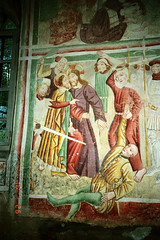Hi everybody!
This image shows a fresco Kiss of Judas in a small Croatian church build in the 13th century – St. Mary of the Rocks in Beram. I’ve chosen this image because it is related to a primary oral culture, i.e. the culture of people unfamiliar with writing. Although I have some previous knowledge on oral cultures, only when I was reading the first chapter of Ong’s Orality&Literacy I realised that I can’t imagine how primary orality looks like. When I was in London I was told that the old inns hadn’t had written names, but pictures on a sign because a large proportion of the population had been illiterate so pictures had been more useful than words. Similar to that, the peasants living in the 13th century in Beram were illiterate and probably the only literate person in the village was a priest. The frescos in the church show scenes from the Bible but adapted to the illiterate audience. This kind of presenting the Bible is called – Biblia Pauperum – the Bible for the poor (meaning illiterate). I think that these examples can make us term primary oral culture more comprehensible. The other reason for choosing this picture was to show you a part of Croatia.
I’ve been working for the Croatian Academic and Research Network – CARNet, a government agency which provides network and related services to Croatian universities and schools. I am a head of the CARNet educational centre. We develop and deliver online courses and educational materials on use of ICT for students and teachers. I live in Zagreb, a capital of Croatia, with my husband Mario and two daughters – Marisa (6) and Romana (2). This is my 9th course at the MET! I’m planning to take my last MET course in December and to come to the graduation ceremony to Vancouver next year. You can reach me at gordana.jugo@carnet.hr. Here’s the link to my e-portfolio http://gordanajugo.wordpress.com
Why I’m in this course? I am familiar with the influence made by print on the society and with the interrelations between technologies and society in general. I think that in order to better understand the impact of new information and communication technologies on teaching and learning and on human in general we need to better understand a broader context including text technologies.
I’m so glad to see so many common faces here. Looking forward to working with all of you!
Gordana




Hi Gordana,
Thoughtful picture and description. I just finished reading the first two chapters and you connected it beautifully.
Nice to see you again!
Lynette
Hi Lynette, thank you. Nice to see you too!
Hi Gordana! Nice to see you again!
Your comment about the Bible for the Poor reminded me of when I lived in England in grade 6. I went to an all-girls convent where most of the teachers were nuns. My religion sister taught us bible stories by drawing huge murals depicting the narrative that eventually filled the entire blackboard while she told the stories. She was an amazing artist AND story teller!